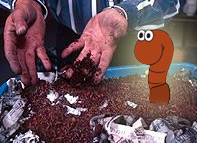|
Studying about composting is a lot more fun when
you use one of nature's best composters, the redworm.
Redworms are great indoor composters. Worm bins
are easy to set up and take care of. They don't smell
either.
|

|
|
Hi, I'm Herman. I've got my own website
and when you've solved all the mysteries, come
learn more about worms with me. |
Your Worm Bin
A worm bin can be any size and made of any type of
material. Shallow (eight to nine inches) containers
are best. Be sure there are drainage holes in the
bottom and holes for air on the side. Be sure to cover
these holes from the inside with fiberglass screen
or old pantyhose to keep the worms in the box.
The Bedding
Worms need bedding to live in. The best and easiest
to use is old shredded newspapers. It takes about
four to six pounds to fill a 2 feet by 2 feet box.
Moisture is also important. Worms need it to help
them breathe. Keep in mind that a worm is about 75
to 90 percent water. Pre-moisten the bedding before
you put in the worms. A general rule of thumb is to
use about three parts water to one part bedding. So,
if you use four pounds of shredded newspaper, you
need to add 12 pounds of water (1 pint = 1 pound).
The Worms
The best worms to use are called red wigglers. These
worms can handle the warm temperatures in a home.
How many worms you need to start your worm composter
depends on the amount of garbage you think you will
generate each day.
Generally, it takes about two pounds of worms to
"eat" about one pound of vegetable waste a day. Once
established, worms are heavy feeders. Worms do best
at temperatures between 55 degrees F and 75 degrees
F. Worms will eat a variety of vegetable waste. Meat
waste should not be used in the bin.
Caring for Your Worm Bin
To care for your worm bin:
-
Watch the moisture levels (don't let it get too
dry or too wet).
-
Provide food.
-
Keep it at the proper temperature.
-
Occasionally removing the castings
(worm manure) that are produced and add fresh
bedding. The castings that are produced can be
used in making potting soil or added to your garden
soil.
|



